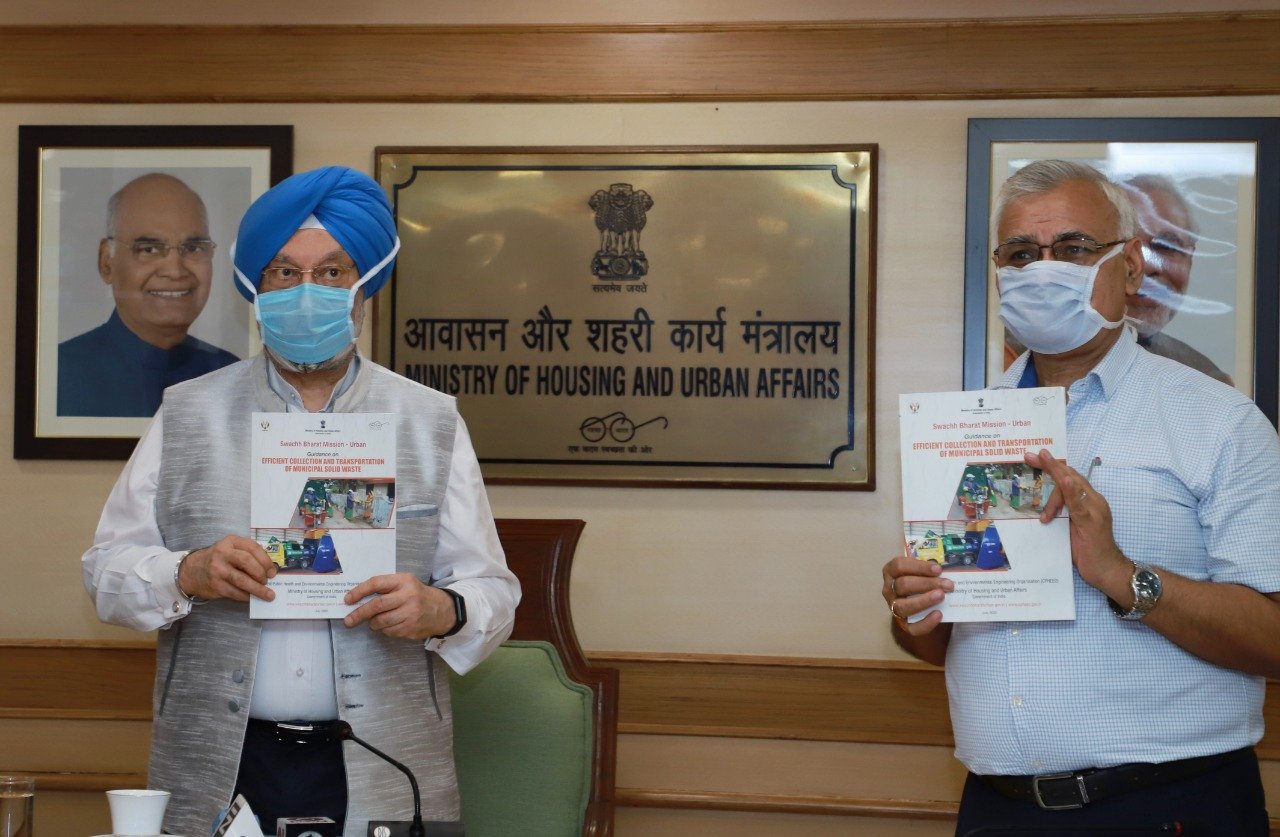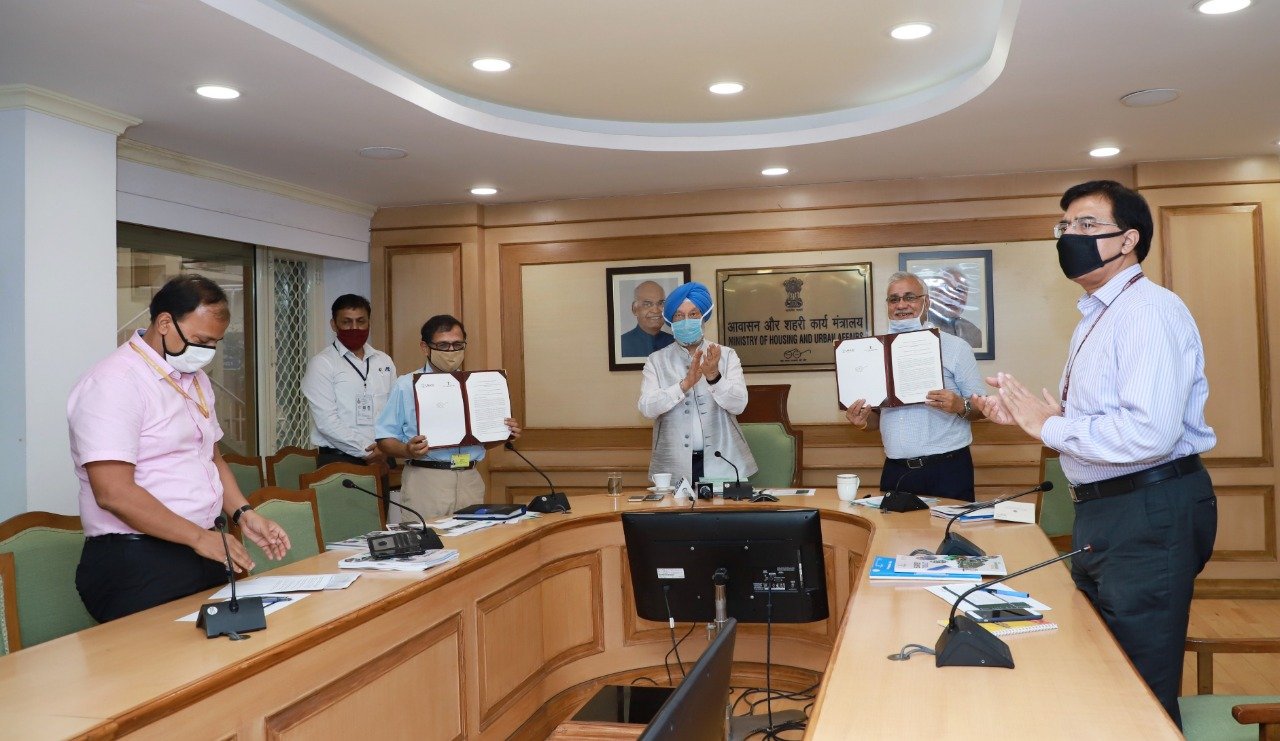Union Minister Hardeep Singh Puri announces a new category of awards titled ‘Prerak Dauur Samman’ as part of Swachh Survekshan 2021

Hardeep Singh Puri, Minister of State (Independent Charge) for Ministry of Housing & Urban Affairs (MoHUA), while launching the toolkit for Swachh Survekshan 2021, the sixth edition of the annual cleanliness survey of urban India conducted by MoHUA has stated that , “Every year, the Swachh Survekshan is redesigned innovatively, to ensure that the process becomes more robust, with focus on sustaining the behaviour change. Like in the last year, keeping in mind the Ministry’s efforts towards ensuring sustainability of the sanitation value chain, the SS 2021 indicators focus on parameters pertaining to wastewater treatment and reuse along with faecal sludge, he added. Also present on the occasion was Durga Shanker Mishra, Secretary, MoHUA who made a detailed presentation on the methodology and various parameters of Swachh Survekshan 2021.
Puri announced a new category of awards titled ‘Prerak Dauur Samman’ as part of Swachh Survekshan 2021.The Prerak Dauur Samman has a total of five additional sub- categories -Divya (Platinum), Anupam (Gold), Ujjwal (Silver), Udit (Bronze), Aarohi (Aspiring) - with top three cities being recognized in each. In a departure from the present criteria of evaluating cities on ‘population category’, this new category will categorize cities on the basis of six select indicator wise performance criteria which are as follows:
• Segregation of waste into Wet, Dry and Hazard categories
• Processing capacity against wet waste generated
• Processing and recycling of wet and dry waste
• Construction & Demolition (C&D) waste processing
• Percentage of waste going to landfills
• Sanitation status of cities
While addressing the participants through a webinar, the Minister also touched upon how Swachh Survekhan has become a tool for citizen engagement in the spirit of a true ‘Jan Andolan’. “This year, the focus on citizen participation has taken a notch higher by introducing indicators that encourage innovations led by citizens, start-ups, entrepreneurs and Swachhata Champions amongst others”. A key highlight of the event was also the launch of the integrated SBM-Urban MIS portal. Over the years, digital innovations have always been at the forefront of the Mission enabling scaling up and better monitoring of outcomes along with increased citizen engagement. The launch of the integrated MIS portal is an effort by the Ministry to bring the numerous digital initiatives on a single platform thus ensuring a unified and hassle-free experience for States and cities and leading the way towards the creation of not just a Swachh but a truly digital India. The virtual event also saw the signing of the Engagement and Coordination Arrangement (ECA) between MoHUA and the USAID which is a continuation of the Memorandum of Understanding (MoU) on co-operation in the field of WASH that was signed between GOI and USAID in 2015.
These launches were followed by a webinar on ‘Segregation at Source: Key to Solid Waste Management’ which was attended by over 1,000 State and Urban Local Body (ULB) officials and other stakeholders. The workshop saw presentations from lighthouse cities such as Navi Mumbai, Surat, Khargone and Karad who showcased their source segregation models along with the release of a report ‘Segregate, Segregate, Segregate’ by the Centre for Science and Environment (CSE). A workshop on ‘Source Segregation: The Key to Solid Waste Management’ was also organized on the sidelines and was attended by over 1000 State and Urban Local Body (ULB) officials and other stakeholders. Similarly, the crucial issues of legacy waste management and remediation of landfills have also been brought to the fore in this edition of Survekshan”.
As a prelude to encouraging cities to improve urban sanitation, MoHUA had conducted Swachh Survekshan 2016 survey for the rating of 73 cities in January 2016, followed by Swachh Survekshan 2017 conducted in January-February 2017 ranking 434 cities. Swachh Survekshan 2018, which became the world’s largest cleanliness survey, ranked 4203 cities followed by Swachh Survekshan 2019 which not only covered 4237 cities but was also the first of its kind completely digital survey completed in a record time of 28 days. Swachh Survekshan 2020 continued the momentum and saw an unprecedented participation of 1.87 crore citizens. Going a step forward, to ensure sustainability of on-ground performance of cities, the Ministry has also introduced Swachh Survekshan League last year, a quarterly cleanliness assessment of cities and towns to be done in three quarters and 25% weightage integrated into the final Swachh Survekshan results.
Since its launch in 2014, Swachh Bharat Mission-Urban (SBM-U) has made significant progress in the area of both sanitation and solid waste management. 4324 Urban ULBs have been declared ODF (4204 certified ODF), 1306 cities certified ODF+ and 489 cities certified ODF++. Moreover, 66 lakhs individual household toilets and over 6 lakhs community/ public toilets have been constructed/ or are under construction. Additionally, over 59,900 toilets across 2900+ cities have been made live on Google Maps. In the area of solid waste management, 96% of wards have 100% door-to door collection while 66% of the total waste generated is being processed. A total of six cities have been certified as 5 Star, 86 as 3 star and 64 as 1 star under the Star Rating Protocol for Garbage Free Cities.
Swachh Survekshan has caught the imagination of citizens and stakeholder alike and the increasing participation with every passing year is testimony to the way in which the citizens have taken complete ownership of the Swachhata of their cities. The survey has thus succeeded in fostering a spirit of healthy competition among towns and cities to improve their service delivery to citizens, towards creating cleaner, more habitable cities. Swachh Survekshan has today made ‘Swachhata’ a thing of motivation and pride – something to look forward to and aspire for. While Mysuru had won the award for the Cleanest City of India in the first edition of the survey, Indore has retained the top position for three consecutive years (2017,2018, 2019). The results for Swachh Survekshan 2020 will be announced shortly by the Ministry.
Knowledge management and capacity building continues to be a key focus of the Ministry. With this objective in mind, the Ministry launched two documents prepared by the Central Public Health and Environmental Engineering Organisation (CPHEEO) – the ‘Advisory on On-Site and Off-Site Sewage Management Practices’ and the guidance book on ‘Segregated Collection and Transportation of Municipal Solid Waste’. While the first will be of immense use to States and cities in adopting integrated on-site and off-site sewage treatment technologies, the latter elaborates on various aspects of segregated waste collection and transportation systems along with case studies and best practices from different ULBs.
